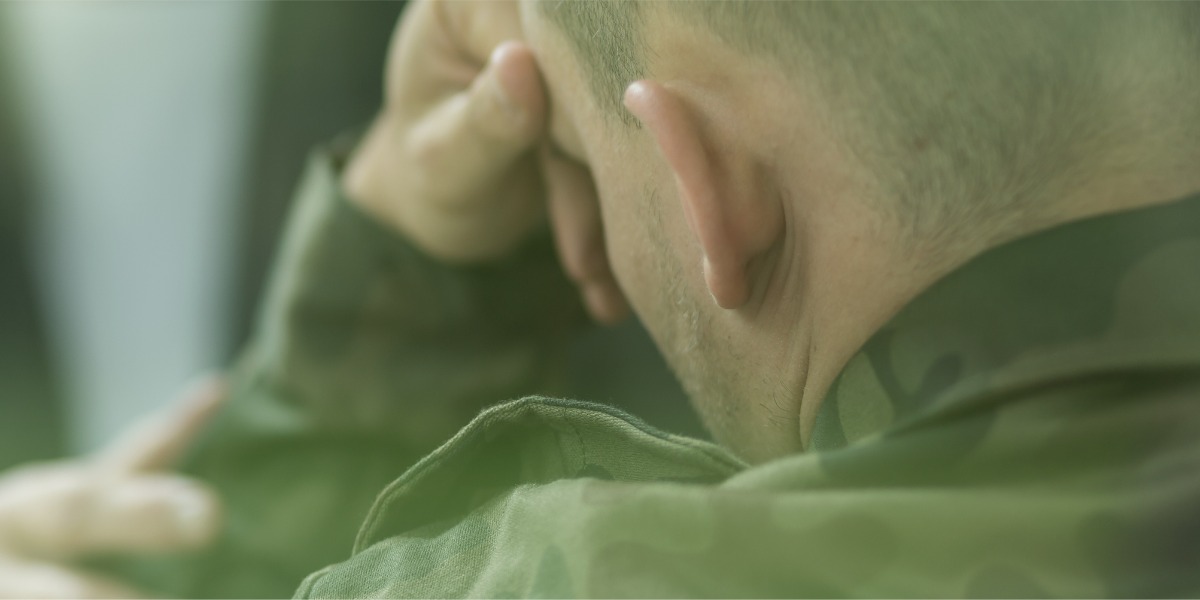Every day in the United States, at least 17 military veterans and one active-duty service member die by suicide – and there’s evidence stigma around mental health contributes to suicide among military veterans.
Veterans are alone in the nationwide suicide epidemic:
- In 2021 alone, the U.S. Centers for Disease Control and Prevention recorded 48,183 deaths, or an average of 132 deaths per day.
- From 2001-2021, the annual rate of suicide deaths among the general public increased by more than 35%.
Yet as bad as this problem is throughout the nation, it appears worse within the military community.
In a population that views traits such as self-reliance and a mission-first mindset as essential characteristics, pervasive stigma against admitting weakness and asking for mental health help complicates the effort to reduce this trend and ensure at-risk service members and veterans get the care they need.
An Ongoing Tragedy
From 2006-2021, suicide accounted for one of every four deaths among active-duty U.S. military members. During this period, suicide caused more deaths than combat, homicide, and terrorism combined.
As an anonymous senior officer told New York Times Magazine contributing reporter Janet Reitman:
“Every generation of soldiers is defined by the conflicts that killed them. For the greatest generation, it was World War II; for baby boomers it was Vietnam; for Gen X it was Iraq and Afghanistan. This new generation, what’s killing them is suicide.”
Active Duty
For active-duty service members, the suicide rate varies among the four main branches, though all report higher rates than the general public.
According to the 2022 edition of the Department of Defense (DoD) Annual Report on Suicide, 492 service members died by suicide in 2022. This represented a rate of 25.1 deaths per 100,000 personnel across all branches.
The suicide rate among individual branches in 2022:
- Marine Corps: 34.9 per 100,000
- Army: 28.9 per 100,000
- Navy: 20.6 per 100,000
- Air Force: 19.7 per 100,000
Also, the Army National Guard had a suicide rate of 24.8 per 100,000 in 2022, while the Army Reserve reported a rate of 20.8 per 100,000.
Military Veterans
Leaving the military does little to diminish risk of death by suicide. The 2023 National Veteran Suicide Prevention Annual Report revealed:
- In 2021, 6,392 U.S. military veterans died by suicide, an average of 17.5 suicide deaths per day.
- In 2001, 6,000 veterans died by suicide. In 2018, 6,718 died by suicide, and increase of 12%.
- In 2001, the annual suicide rate among U.S. veterans was 23.3 per 100,000 veterans.
- By 2021, the suicide rate among veterans had increased to 33.9 per 100,000, an increase of 45%.
- In 2021, the suicide rate among non-veterans was 7 per 100,000
Among veterans, the suicide risk appears to be greatest during the first year after discharge.
According to the DoD report referenced earlier, in 2020 the suicide rate among veterans who separated from the military in 2019 was 47.6 per 100,000, which is 185 percent higher than the rate among the general population.
Contributing Factors
It’s no secret military members endure substantial stress and pressure on a regular basis. In addition to facing the unique challenges of military service, they also must deal with everyday stressors such as maintaining relationships, managing finances, and caring for their families.
As retired Brigadier General Steven Xenakis, MD, told the New York Times:
“It’s not normal. It’s a climate rooted in constant pressure, constant movement and constant trauma. And the legacy of that trauma and combat cascades down on the soldiers.”
Experts theorize this combination of personal and systemic factors has a significant influence on the elevated rates of suicide deaths among military members.
Personal Challenges
The DoD’s Annual Report on Suicide included the following anonymized information about the service members who took their own lives in 2022:
- 45% had a behavioral health diagnosis, such as alcohol use disorder (AUD), depression, or a trauma-related condition.
- 42% had problems within the context of an intimate relationship
- 26% had workplace difficulties
- 26% had administrative or legal problems
- 10% had financial problems within a year before their death
The DoD report didn’t establish a direct cause-effect relationship between these experiences and the service members’ deaths. But research indicates that they can all increase risk of suicidal thoughts and behaviors.
An April 2021 report from the U.S. Army Public Health Center, Division of Behavioral and Social Health Outcomes Practice (BSHOP) reinforces the significant influence of personal factors like these. That document noted the likelihood of past-month suicidal thoughts increased dramatically among service members who had:
- Severe sleep problems: 253%
- Depression: 177% increase
- Loneliness: 93% increase
- Anxiety: 62% increase
- PTSD: 54% increase
- Hazardous drinking: 40% increase
Systemic Obstacles
In addition to personal challenges mentioned above, system-wide obstacles may also increase risk of considering or attempting suicide.
For example, for former service members with suicidal thoughts or other psychological concerns, making an appointment with a mental health professional presents problems:
- The Veterans Administration (VA) indicates that former service members typically wait about 22 days for an initial mental health appointment at a VA facility.
- A civilian study found that, depending on location, the average wait time for a VA mental health appointment ranges from 24.7 to 42 days.
For active-duty personnel, one of the greatest systemic obstacles to better mental health and diminished risk of suicide is stigma.
Suicide and Mental Health: The Impact of Stigma on Military Veterans
Mental health stigma is not a new problem in the military.
In 2015, the journal Epidemiologic Reviews published a meta-analysis of 20 papers from 2000-2014 that explored mental health stigma in the military in the U.S., UK, and Canada.
According to that report, as many as 60 percent of military members with mental health challenges don’t seek treatment. Among those, the most common stigma-related reasons were:
- My unit leadership might treat me differently: 44.2%
- I would be seen as weak: 42.9%
- Members of my unit might have less confidence in me: 41.3%
- It would be too embarrassing: 36.1%
- It would harm my career: 33.4%
- My leaders would blame me for the problem: 5.5%
Dr. Nancy Skopp, a psychologist with the Defense Health Agency’s Psychological Health Center of Excellence, noted the emphasis on strength and resilience may prevent service members from getting effective treatment.
Some service members view seeking help as a sign of:
“…weakness, social inferiority, and/or a lack of resourcefulness. These feelings may be attributable to the culture within individual military units. For example, warrior ethos emphasizes discipline, mental toughness, and self-sufficiency, and foremost attention to successful mission execution.”
Addressing the Problem: Mental Health Stigma in the Military
In September 2023, U.S. Secretary of Defense Lloyd Austin released a memorandum titled “New DoD Actions to Prevent Suicide in the Military.”
After what Austin described as more than two years of “unprecedented action to counter harmful behavior in all its forms, including suicide,” he explained the DoD’s suicide prevention efforts prioritize five key areas:
- Foster a supportive environment: This includes quality-of-life initiatives for military members and their families, such as expanded parental leave, increased employment opportunities for military spouses, and universal pre-K programming in DoD schools.
- Improve the delivery of mental health care: This involves recruiting and retaining more mental health providers and increasing the availability of appointments for mental health services.
- Address stigma and other barriers to care: This area includes expanding access to confidential suicide prevention services, offering more mental health services in primary care facilities, providing unit-level resources to encourage stigma reduction, and increasing telehealth options.
- Revise suicide prevention training: Austin described efforts in this area as “a foundational shift toward a comprehensive integrated prevention strategy” that places increased focus on the stressors that military members commonly encounter.
- Promote a culture of lethal means safety: Most military deaths by suicide involve firearms. To reduce this risk, Austin announced initiatives to promote greater awareness and ensure the secure storage of both government-issued and privately-owned weapons.
Austin ended the memorandum with a call for unified action and a truly comprehensive approach:
“We must foster trust and connection in the workplaces and communities under our care. We must integrate prevention into all our efforts. And we must reach out to those who are struggling and make it easier to seek help.”
Get Help Today
If you or someone you care about is at risk of suicide, please get help immediately:
- If the danger is immediate, call 911 now.
- If the danger is serious but risk of harm is not immediate – meaning about to happen now – call or text the 988 Suicide & Crisis Lifeline at 988.
- The 988 crisis line connects callers trained professionals who can assess your needs and refer you to an appropriate resource in your area.
If you have recurring thoughts of suicide, but you are not in immediate danger, a residential or outpatient program may be right for you.
Crownview Psychiatric Institute offers customized care in a dynamic community-like environment for adults whose lives have been disrupted by suicidal ideation and a variety of other acute mental health concerns. To learn more about treatment options at our center, please visit our Contact page or call us today.


 Gianna Melendez
Gianna Melendez Jodie Dahl, CpHT
Jodie Dahl, CpHT